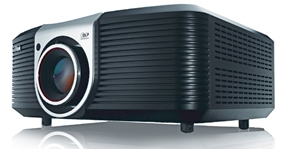Guide To LED Technology Page 3

Projector image at top: Vivitek's H9080FD is the first LEDdriven home theater front projector to hit the market.
LED PROJECTED
LEDs can also be used as a light source for video projectors. They were first introduced in rear-projection TVs in 2006, but that product category has all but disappeared. In the last year, they've reappeared in front projectors. High-powered white LEDs are used in the new pocket projectors like the Optoma Pico and in the projector built into the new Nikon Coolpix S1000pj digital camera. More exciting to home theater fans, though, are the new home front projectors driven by separate red, green, and blue LEDs. At press time, the first of these, Vivitek's H9080FD, had just begun shipping. The LEDs in these projectors are called Phlat- Light LEDs, and they're made by an MIT spinoff company named Luminus Devices. Phlat-Light LEDs differ from conventional ones in that the core LED is integrated with a photonic matrix, a structure whose components measure only a few hundred nanometers (less than one millionth of a millimeter) in size. The matrix directs the LED's light forward in a way that is far more efficient and effective than using a lens.
In these projectors, light from the LEDs reflects off a Texas Instruments DLP chip to produce a video image. The first LED-driven projectors use a single DLP chip. The projector flashes the red, green, and blue LEDs sequentially, so the color wheel found in lampbased projectors is not needed. Your brain combines the separate red, green, and blue images into a single full-color image. Stephane Bellosguardo, director of product marketing for Luminus Devices, says that the Phlat- Light concept is technology-agnostic and that we can expect to see LED-driven LCD and/or LCoS projectors within two years.
The main benefit of LEDs for front projection is that LEDs last much longer than the UHP lamps used in almost all current projectors. A typical lamp lasts 2,000 to 3,000 hours. In comparison, Vivitek rates the lifetime of the LEDs in its new H9080FD projector at 20,000 hours. Vivitek senior product manager Chris Yang suggests that the actual lifespan may be longer. "This could be considered a conservative rating. A lot of it is calculated. These projectors haven't been around long enough for us to know exactly how long the LEDs will last." Projectiondesign is considerably less conservative; according to the company's Dan Miller, the LEDs in its new Kroma projector are rated for more than 50,000 hours, and the company touts a lifetime of more than 100,000 hours for the LEDs in its new FL32 series projectors.
These figures mean that the LEDs should last for the lifetime of the projector. An LED rated for 20,000 hours of life will last through 8 hours of use every single day for 6.8 years. So by the time its LEDs expire, the projector is likely to be obsolete anyway.
Another benefit that projection enthusiasts will enjoy is the LED's consistent performance. According to Miller, LEDs "never really change their characteristics" - in other words, they won't darken over time. UHP lamps usually start to noticeably dim and shift in color after 1,000 to 1,500 hours, and by the time they're ready for replacement, the image may be greatly degraded.
"After 10,000 or more hours of aging, the LEDs are still within 10% of their original brightness," Bellosguardo says. "There will be some slow degradation, but not something users will be able to perceive. And the color characteristics are very stable over time."
For the videophile, LED-driven projectors can also offer certain picture-quality advantages compared with lamp-based models. As with LED-illuminated LCD TVs, the color gamut is wider. LEDs may also deliver better contrast because, unlike lamps, their brightness can be changed in a microsecond to optimize the output for each individual video frame. Of course, the auto iris systems in today's lamp-based projectors work the same way, but these often create distracting "pumping" effects as the brightness level changes. According to Vivitek's Yang, LEDs can change their brightness so quickly that the artifacts seen with auto iris systems "can definitely be eliminated."
Each of the PhlatLight LEDs used in the Projectiondesign and Vivitek projectors is designed to run at up to 100 watts, so at full output the power consumption is comparable to a UHP lamp. However, because the LEDs can deliver the precise brightness level required by an application rather than the two levels of brightness that a UHP lamp in a typical projector delivers, they do offer some potential for power savings. Also, LEDs take only a few seconds to warm up, versus about two minutes for a typical UHP projector lamp, and they can be shut off instantly without the need for a cool-down cycle.
There are a couple of downsides to LEDdriven home theater projectors, at least for now. The first models are frightfully expensive: Vivitek's costs $15,000, and Projectiondesign's Dan Miller expects his company's Kroma models to start at prices above $30,000 when they ship later this year.
Part of this high cost is simply because the technology is new. Another part of it, though, is that the LEDs are being run at extraordinarily high power levels. The highintensity LEDs in a bike light might run at 3 volts and 1 amp, but Miller says Projectiondesign is running the LEDs in its projectors at 12 volts and 30 amps. Vivitek uses large heat sinks and fans to keep its LEDs cool, while Projectiondesign uses heat pipes - in essence, liquid cooling. The cooling systems dictate large form factors; the Kroma uses the same chassis as the Projectiondesign Avielo Optix, and the Vivitek is about 18 inches long and weighs in at a portly 46 pounds.
Another disadvantage of the first LEDdriven projectors is low image brightness. Yang says Vivitek's H9080FD delivers 800 lumens, while Miller reports that the Kroma produces "an honest, calibrated 650 to 700 lumens." Even a modestly priced lamp-driven home theater projector can deliver 1.5 to 2 times those figures, but as Miller puts it, "It doesn't take a whole lot of output to achieve SMPTE levels [the same screen brightness as specified for a commercial cinema], and it doesn't take a lot more to achieve desirable levels."

A cross-section view of a typical full-array backlit LED LCD TV. The set's diffuser panel and color filter are sandwiched between the LEDs and the LCD panel.
THE FUTURE OF LED
There's no doubt that LEDs will play a huge role in video displays for many years to come. According to DisplaySearch, LEDbacklit LCD TVs will surpass sales of CCFLdriven sets in 2014. Every major TV manufacturer now offers an LED/LCD TV - even the price-aggressive Vizio, which at press time was just about to start shipping its $2,199 VF551XVT. Because full-array and edge-lit sets each offer significant advantages and disadvantages relative to the other, expect the two technologies to coexist for several years.
Predicting the future of LED-driven home theater projectors is tougher. At press time, Vivitek and Projectiondesign - along with Runco, which plans to ship a model in the $15,000 price range come November - were the only companies that had announced such products. Because these manufacturers are pushing LED technology to such extremes, the path to lower prices, more compact chassis, brighter pictures, and greater market acceptance isn't necessarily clear. "Because LED is a fairly new technology [for projection], the prices will probably fall at a gradual rate," Vivitek's Chris Yang says. "They won't drop the way they did for 1080p projectors." Still, Luminus Devices' Bellosguardo predicts that the next generation of LED projectors will include relatively compact models in the $4,000 to $6,000 range.
As new government regulations require reduced energy consumption from TVs, video display manufacturers will find LEDs the easiest way to achieve their goals for more of their products. As Samsung's Tanenbaum puts it, "LEDs will be significant for many years to come."
- Log in or register to post comments























































